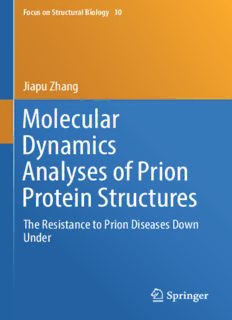
Molecular Dynamics Analyses of Prion Protein Structures PDF
Preview Molecular Dynamics Analyses of Prion Protein Structures
Focus on Structural Biology 10 Jiapu Zhang Molecular Dynamics Analyses of Prion Protein Structures The Resistance to Prion Diseases Down Under Focus on Structural Biology Volume 10 Serieseditor RobertKaptein,BijvoetCenterforBiomolecularResearch,UtrechtUniversity, TheNetherlands Moreinformationaboutthisseriesathttp://www.springer.com/series/5990 Jiapu Zhang Molecular Dynamics Analyses of Prion Protein Structures The Resistance to Prion Diseases Down Under 123 JiapuZhang FacultyofScienceandTechnology TheFederationUniversityAustralia MountHelen,Victoria,Australia ISSN1571-4853 ISSN1571-4853 (electronic) FocusonStructuralBiology ISBN978-981-10-8814-8 ISBN978-981-10-8815-5 (eBook) https://doi.org/10.1007/978-981-10-8815-5 LibraryofCongressControlNumber:2018943680 ©SpringerNatureSingaporePteLtd.2018 Thisworkissubjecttocopyright.AllrightsarereservedbythePublisher,whetherthewholeorpartof thematerialisconcerned,specificallytherightsoftranslation,reprinting,reuseofillustrations,recitation, broadcasting,reproductiononmicrofilmsorinanyotherphysicalway,andtransmissionorinformation storageandretrieval,electronicadaptation,computersoftware,orbysimilarordissimilarmethodology nowknownorhereafterdeveloped. Theuseofgeneraldescriptivenames,registerednames,trademarks,servicemarks,etc.inthispublication doesnotimply,evenintheabsenceofaspecificstatement,thatsuchnamesareexemptfromtherelevant protectivelawsandregulationsandthereforefreeforgeneraluse. Thepublisher,theauthorsandtheeditorsaresafetoassumethattheadviceandinformationinthisbook arebelievedtobetrueandaccurateatthedateofpublication.Neitherthepublishernortheauthorsor theeditorsgiveawarranty,expressorimplied,withrespecttothematerialcontainedhereinorforany errorsoromissionsthatmayhavebeenmade.Thepublisherremainsneutralwithregardtojurisdictional claimsinpublishedmapsandinstitutionalaffiliations. Printedonacid-freepaper ThisSpringerimprintispublishedbytheregisteredcompanySpringerNatureSingaporePteLtd. The registered company address is: 152 Beach Road, #21-01/04 Gateway East, Singapore 189721, Singapore TomybrotherJiaqingZhang whowasdeprivedofeducationbecause ofourfamilypovertyandtomydearwife XiaoYanYuan Preface Unlikebacteriaandviruses,whicharebasedonDNAandRNA,prionsareunique as disease-causing agents since they are misfolded proteins. Prions propagate by deforming harmless, correctly folded proteins into copies of themselves. The misfoldingisirreversible.Prionsattackthenervoussystemoftheorganism,causing anincurable,fataldeteriorationofthebrainandnervoussystemuntildeathoccurs. Some examples of these diseases are bovine spongiform encephalopathy (BSE) (or called “mad cow” disease) in cattle, chronic wasting disease (CWD) in deers andelksinNorthAmerica;Creutzfeldt-Jakobdiseases(CJDs)(includingsporadic CJD (sCJD), hereditary/familiar CJD (fCJD), iatrogenic CJD (iCJD), variant CJD (vCJD)), fatal familial insomnia (FFI), Gerstmann-Stra¨ussler-Scheinker syndrome (GSS), Huntington disease-like 1, kuru, and the recently discovered variably protease-sensitiveprionopathyinhumans;felinespongiformencephalopathy(FSE); transmissible mink encephalopathy (TME); ungulate spongiform encephalopathy (USE) (or called exotic ungulate encephalopathy (EUE)); scrapies in sheep and goats; etc. Prion diseases are called protein “structural conformational” diseases, because prion contains no nucleic acids, and it is a misshapen or conformation- changed protein that acts like an infectious agent. The conformational change is fromanormalcellularprionprotein(PrPC)toadiseasedinfectiousprion(PrPSc). PrPC is predominant in α-helices, but PrPSc is rich in β-sheets in the form as amyloid fibrils (cross-β structures), and now numerous experimental structures of PrPCs(producedbyX-raycrystallographyandnuclearmagneticresonance(NMR) spectroscopy,etc.)areavailableintheProteinDataBank(PDBBank),sothatitis veryamenabletobestudiedbymoleculardynamics(MD)techniques. This book is on MD studies nearly for every PrPC structure with a PDB entry in the PDB Bank at different temperatures (mainly at room temperature 300K) underloworneutralpHenvironmentsfor30ns’MDsimulations.Chapter1ofthis bookistogivesomebasicknowledgeonMD,statisticalmechanics(SM),quantum mechanics (QM), and the MD and optimization methods used in this book. Then thisbookisconsistingoffiveparts(PartsI,II,III,IV,andV)brieflydescribedas follows. vii viii Preface PartI,noteveryspeciesisaffectedbypriondisease;rabbits,dogs,horses,water buffalo,pigs,chicken,turtles,andfrogsarelowlysusceptibletopriondiseases.We will well address all these immunity species at 300, 350, 450K under low pH or neutralpHenvironments: • Chapter2Rabbit 2.1 TheWild-TypeNMRStructure(PDBEntry2FJ3) 2.2 TheWild-TypeX-rayStructure(PDBEntry3O79) 2.3 TheI214VMutant(NMRStructurePDBEntry2JOM) 2.4 TheS173NMutant(NMRStructurePDBEntry2JOH,X-rayStructurePDB Entry4HMM) 2.5 TheS170NMutant(X-rayStructurePDBEntry4HLS) 2.6 TheS170NandS174NMutants(X-rayStructurePDBEntry4HMR) 2.7 TheStructureWithouttheDisulfideBond(SS)(HomologyStructure) • Chapter3Dog 3.1 TheWild-TypeNMRStructure(PDBEntry1XYK) 3.2 TheD159NMutant(HomologyStructure) • Chapter4Horse,Buffalo,andPig 4.1 Horse’sWild-TypeNMRStructure(PDBEntry2KU4) 4.2 Buffalo’sHomologyStructure 4.3 Pig’sWild-TypeNMRStructure(PDBEntry1XYQ) • Chapter5Chicken,Turtle,andFrog 5.1 Chicken’sWild-TypeNMRStructure(PDBEntry1U3M) 5.2 Turtle’sWild-TypeNMRStructure(PDBEntry1U5L) 5.3 Frog’sWild-TypeNMRStructure(PDBEntry1XU0) We will try to find out reasons why the protein in a resistant species allows it to retain its folding. To compare with the above resistantspecies, other PrPC models and doppel models (at 300K in neutral pH environment) are also MD studied in PartI(Chap.6): • Chapter6OtherSpecies 6.1 SyrianHamster’sWild-TypeNMRStructure(PDBEntry1B10) 6.2 Bovine 6.2.1 TheWild-TypeNMRStructure(PDBEntry1DWY) 6.2.2 TheN-TerminalPrP(1–30)(PDBEntry1SKH) 6.3 Sheep,Ovine,OvisAries 6.3.1 TheWild-TypeX-rayStructure(PDBEntry1UW3) 6.3.2 The Sheep Q168H Mutant (PDB Entry 1XYU) at 300K in Low or NeutralpHEnvironments) 6.3.3 TheSheepPrPC(135–155)(PDBEntry1S4T) Preface ix 6.3.4 The Sheep PrPC(142–166) with Mutation Y155A/R156A (PDB Entries2RMV/W) 6.3.5 The Ovine Q168R Mutant (PDB Entry 1Y2S) at 300K in Low or NeutralpHEnvironments) 6.3.6 The Ovine H2H3 Domain (PDB Entry 2KTM) at 300K in Low or NeutralpHEnvironments) 6.3.7 OvisAries 6.3.7.1 TheWild-TypeNMRStructure(PDBEntry2N53) 6.3.7.2 TheOvisAriesΔ190–197(PDBEntry2MV8) 6.3.7.3 TheOvisAriesΔ193–196(PDBEntry2MV9) 6.3.7.4 TheOvisAriesPrP(145–169)(PDBEntry1M25) 6.4 Cat’sWild-TypeNMRStructure(PDBEntry1XYJ) 6.5 Doppel 6.5.1 TheHumanDoppelProtein(PDBEntry1LG4) 6.5.2 MouseDoppelProteins 6.5.2.1 TheWild-Type(PDBEntry1I17) 6.5.2.2 TheSinglePeptide1–30(PDBEntry1Z65) 6.5.3 TheOvineDoppelSinglePeptide1–30(PDBEntry2M1J) All the mutants of mouse PrP and human PrP are studied in this book. Part II ◦ studies mouse PrP (NMR structures at 37 and 20 C respectively), all mouse PrP mutants,andotherPrPspecieswhichownahighlyandclearlyorderedβ2-α2loop (theloopbetweenβ-strand2andα-helix2ofPrP).Mousemutationsintheβ2-α2 loop and in the C-terminal will bring structures with a highly and clearly ordered β2-α2loop.Whyistheβ2-α2loopinprionprotein(PrPC)afocusforresearchers andwhatistherolethatmousePrPmutantsplay?Withthesequestionsinmind,we willfocusontheβ2-α2loopdoingMDanalysesforthefollowingmodelsat300K underloworneutralpHenvironments: • Chapter7Mouse’sWild-TypeNMRStructures ◦ 7.1 The37 C(310.2K)Structure(PDBEntry2L39) ◦ 7.2 The19.85 C(293K)Structure(PDBEntry1AG2) ◦ 7.3 The19.85 C(293K)Structure(PDBEntry1XYX) • Chapter8Mouse’s11Mutants 8.1 TheV166AMutant(PDBEntry2KFO) ◦ 8.2 TheD167SMutantat20 C(PDBEntry2KU5) 8.3 TheD167S-N173KMutant(PDBEntry2KU6) 8.4 TheY169GMutant(PDBEntry2L1D) 8.5 TheY169AMutant(PDBEntry2L40) 8.6 TheS170NMutant(PDBEntry2K5O) 8.7 TheS170N-N174TMutant(PDBEntry1Y16) x Preface 8.8 TheN174TMutant(PDBEntry1Y15) 8.9 TheF175AMutant(PDBEntry2L1E) 8.10 TheY225A-Y226AMutant(PDBEntry2KFM) ◦ 8.11 TheY169A-Y225A-Y226A-20 CMutant(PDBEntry2L1K) • Chapter9OtherSpecieswithanOrderedβ2-α2Loop 9.1 BankVale(ClethrionomysGlareolus)(PDBEntry2K56) 9.2 TammarWallaby(MacropusEugenii)(PDBEntry2KFL) 9.3 Elk(PDBEntry1XYW)at300,350,450KinLoworNeutralpHEnviron- ment 9.4 Rabbits 9.4.1 NMR Structure (PDB Entry 2FJ3) at 300, 350, 450K in Low pH or NeutralpHEnvironment(Sect.2.1) 9.4.2 X-ray Structure (PDB Entry 3O79) at 300, 350, 450K in Low or NeutralpHEnvironment(Sect.2.2) 9.5 Horse (PDB Entry 2KU4) at 300, 350, 450K in Low or Neutral pH Environment(Sect.4.1) 9.6 Pig(PDBEntry1XYQ)at300,350,450KinLoworNeutralpHEnviron- ment(Sect.4.3) Human mutations cause prion diseases such as CJD, GSS, and FFI (especially some CJDs and the GSS are mainly caused by mutations). In Part III, firstly, we willdoMDanalysesforthefollowinghuman16mutantsat300KunderneutralpH environment: • Chapter10Human’s16Mutants ∗ 10.1 ThePrP226 (PDBEntry5L6R) 10.2 TheR220KMutant(PDBEntries1E1U/W) 10.3 TheE219KMutant(PDBEntry2LFT) 10.4 TheQ212PMutant(PDBEntry2KUN) 10.5 TheV210IMutant(PDBEntries2LEJ/V1) 10.5.1 ThepH5.5Structure(PDBEntry2LEJ) 10.5.2 ThepH7.2Structure(PDBEntry2LV1) 10.6 TheV209MMutant(PDBEntry2M8T) 10.7 TheE200KMutant(PDBEntries1FKC/O7) 10.8 TheF198SMutants 10.8.1 WithM129(PDBEntry3HES) 10.8.2 WithV129(PDBEntry3HER) 10.9 TheD178NMutants 10.9.1 TheD178NMutant(PDBEntry3HEQ) 10.9.2 TheD178N-M129VMutant(PDBEntry3HJX)pH7.0Structure 10.9.3 TheD178N-M129VMutant(PDBEntry2K1D)pH4.6Structure
Description: